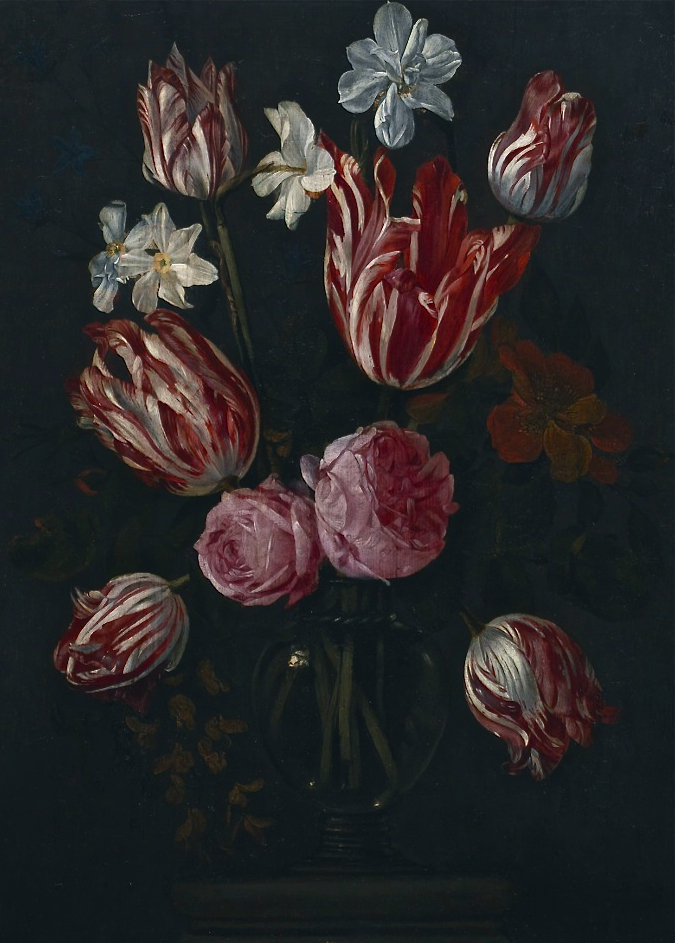

Title: Unique Antique Still Life Painting By Christiaan Luycks Belgian
Shipping: $29.00
Artist: N/A
Period: 15th Century
History: N/A
Origin: N/A
Condition: Museum Quality
Item Date: 1623-1658
Item ID: 6457
Still Life Painting By Christiaan Luycks (Belgian, 1623-1658): Floral Still Life. Oil on cradeled panel, signed with "KL" monogram at the lower center, in a wide Dutch style frame in black lacquer finish, 28 x 23-3/4 in. overall. Provenance: The Harry R. Calsing Trust, Cleveland Ohio. Acquired at Sotheby's sale 7803, lot 27, 6/5/02, labels verso. Sotheby's catalog entry "We are grateful to Fred Meijer of the Rijksbureau voor Kunsthistorische Documentatie, The Hague for confirming the attribution to Luyckx, based on photographs. He believes it is most likely an early work based on comparison with the flowers by Luyckx in a painting in the National Gallery Warsaw (formerly in the Lazienski collection). The central image of that painting is by David Teniers, signed and dated 1650." Born in Antwerp, pupil of de Marlier and of Francken III, known for still life and vanitas paintings, becoming extremely successful in his lifetime. Condition: Some light worming seen on the verso of the panel. Discrete areas of inpainting seen under UV light, older varnish layers and soils probably mask other treatments. Craquelure in - Our job is to find and target great art by collecting a vast array of contemporary, vintage, antique and collectible items from across the globe. Individually handcrafted, we breathe new life into these forgotten relics by giving back each piece it's unique story. *All of the art is edited and chosen by us for its high quality and workmanship before posting. These collectibles have been selected with the artist & collector in mind. We are committed to enhancing our customer’s lives by discovering creating, and pointing out only the best art we can find in the world today. We Are Taste-Makers, Art Advisers, Consultants & Publishers Of Spectacular Art Stories. Our job is to be intermediaries between buyers and sellers. We are vetting for high end art patrons. We are determined to catalog the world's most exceptional art and share it with everyone.
Link: http://en.wikipedia.org/wiki/Still_life
A still life (plural still lifes) is a work of art depicting mostly inanimate subject matter, typically commonplace objects which may be either natural (food, flowers, dead animals, plants, rocks, or shells) or man-made (drinking glasses, books, vases, jewelry, coins, pipes, and so on). With origins in the Middle Ages and Ancient Graeco-Roman art, still-life painting emerged as a distinct genre and professional specialization in Western painting by the late 16th century, and has remained significant since then. Still life gives the artist more freedom in the arrangement of elements within a composition than do paintings of other types of subjects such as landscape or portraiture. Early still-life paintings, particularly before 1700, often contained religious and allegorical symbolism relating to the objects depicted. Some modern still life breaks the two-dimensional barrier and employs three-dimensional mixed media, and uses found objects, photography, computer graphics, as well as video and sound.
Still life emerged from the painting of details in larger compositions with subjects, and historically has been often combined with figure subjects, especially in Flemish Baroque painting. The term includes the painting of dead animals, especially game. Live ones are considered animal art, although in practice they were often painted from dead models. The still-life category also shares commonalities with zoological and especially botanical illustration, where there has been considerable overlap among artists. Generally a still life includes a fully depicted background, and puts aesthetic rather than illustrative concerns as primary. Still life occupied the lowest rung of the hierarchy of genres, but still has been extremely popular with buyers. As well as the independent still-life subject, still-life painting encompasses other types of painting with prominent still-life elements, usually symbolic, and "images that rely on a multitude of still-life elements ostensibly to reproduce a 'slice of life'. The trompe-l'œil painting, which intends to deceive the viewer into thinking the scene is real, is a specialized type of still life, usually showing inanimate and relatively flat objects.